It’s the week of Fourth of July. And while we appreciate you being here, we really hope it’s from some stretch of sand or some body of water relaxing enough that your problems can be put on the same kind of ice as the booze in the cooler next to you. If not, throw on your shades anyway, and join us for our weeklong package, “Life’s a Beach,” a celebration of all things sand, sun and summer. Of course, if you’re already on vacation, you’re welcome, too — just be sure to reapply another layer of sunscreen, as these pieces burn bright. Read all of them here.
The sands of the Salton Sea are at complete odds with each other. In some areas, they’re soft and flour-like, more Caribbean island than Southern California desert. In others, they look as though a giant clay pot has exploded and all of the subsequent fragments were drenched in oil. Their only real similarity are the calcified fish bones that line every part of the beach, no matter its terrain. The sea water shares this dichotomy. Up close, it’s vast and clear enough that you expect to see dolphins surface along the waterline. But from a bird’s-eye view, it looks as though it’s helping to contain a snarling dust storm.
This is all why you’ll hear people say that the Salton Sea feels “like being on a different planet.” But that’s not exactly right. Because everything is too familiar. Too much like Earth.
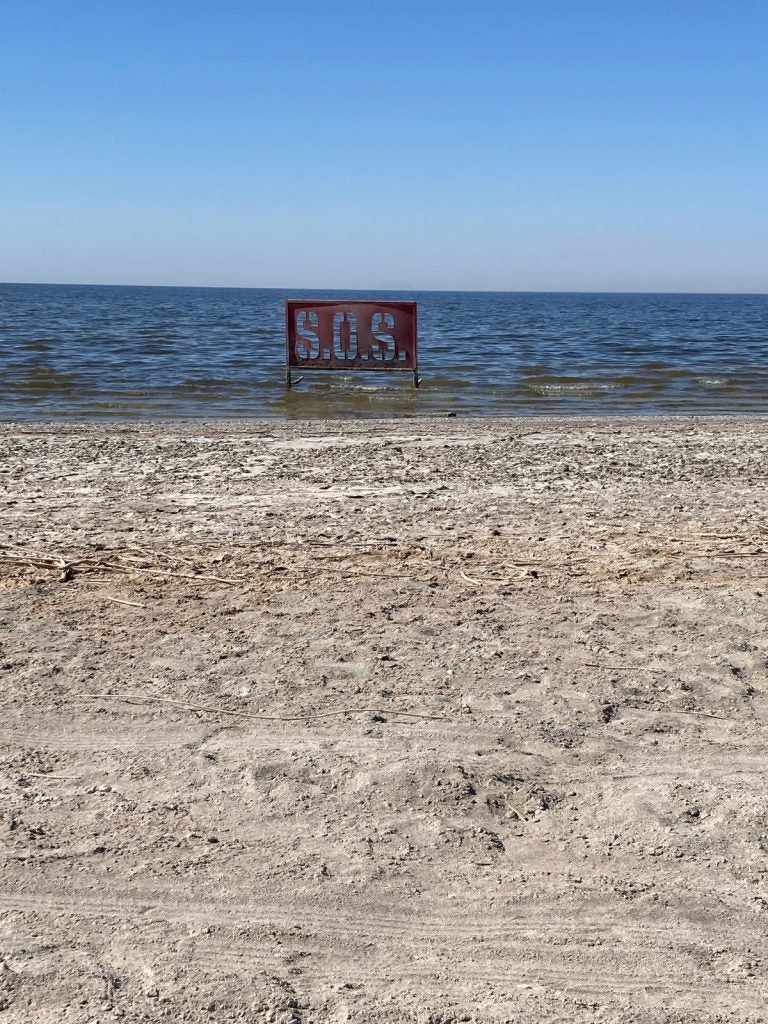
It’s an early evening in June, and the sky in Bombay Beach — population: 215, and the remaining community along the Salton Sea — is bleeding red and orange. The sun is disappearing behind the San Jacinto Mountains, a sign that there’s an overabundance of pollution in the air. The smell, due to an algae bloom, has been described as “fetid,” “noxious” and like “rotten eggs.” It supposedly gets worse as the heat becomes more tyrannical. But although the temperature is approximately 100 degrees (fairly common for this time of year), I’d describe it as mildly septic.
From the berm that was built in the 1980s as a failed attempt to prevent the sea from swallowing up the town, I can see a Tesla charger station made of scrap metal and a wood confessional near a phone booth with its handset dangling inches from the sand, along with a metal sign in the shallows that reads “The Only Other Thing Is Nothing.” It’s here that I meet April, a Bombay Beach local who makes me promise I won’t use the terms “post-apocalyptic,” “abandoned” or “ghost town” to describe her hometown of the last six years. Like many of Bombay’s residents, she’s tired of visitors misrepresenting its soul. It, of course, used to be none of these things. In fact, Bombay Beach was once a blue-collar paradise — the best-kept secret in California.

The sea itself first arrived in 1905 when the Colorado River flooded and overwhelmed a dam that was built to divert the river’s excess to a dry riverbed. The water traveled roughly 200 miles to the middle of the desert in a classic story of how man conquers nature only for nature to strike back. This, again, is something non-locals love to pick on, referring to it as “the only accident you can see from space.” But Steve Johnson, who first came to Bombay Beach in 1964 when he was three, says the water is just part of the natural cycle of the Colorado River’s overflow. “It’s not an accident,” he tells me. “It was an accident that the sea had been dry for so long. The Salton Sea would have been inevitable.”
Depending on which rumor you choose to believe, the beach is either named after the 300 bomb casings that were used during practice missions for the atomic bomb attacks on Hiroshima and Nagasaki, or because the desert heat reminded the original settlers of Bombay, India (since renamed Mumbai). Either way, by the 1960s, the Salton Sea and its surrounding enclaves had become a place for families looking to vacation and water ski, attracting even the likes of Frank Sinatra and Desi Arnaz. Bombay Beach, though, mostly drew a blue-collar crowd from the San Gabriel Valley, San Diego and Long Beach. “We came here when it was dirt roads, a water tank up on the roof and a bucket of lime and a hole in the ground for the toilet,” says Keith Jones, whose presence here dates back to 1961 when he was eight years old. “Then, in the mid-1960s, the paved streets came into town, water came into town and the sewer came into town.”
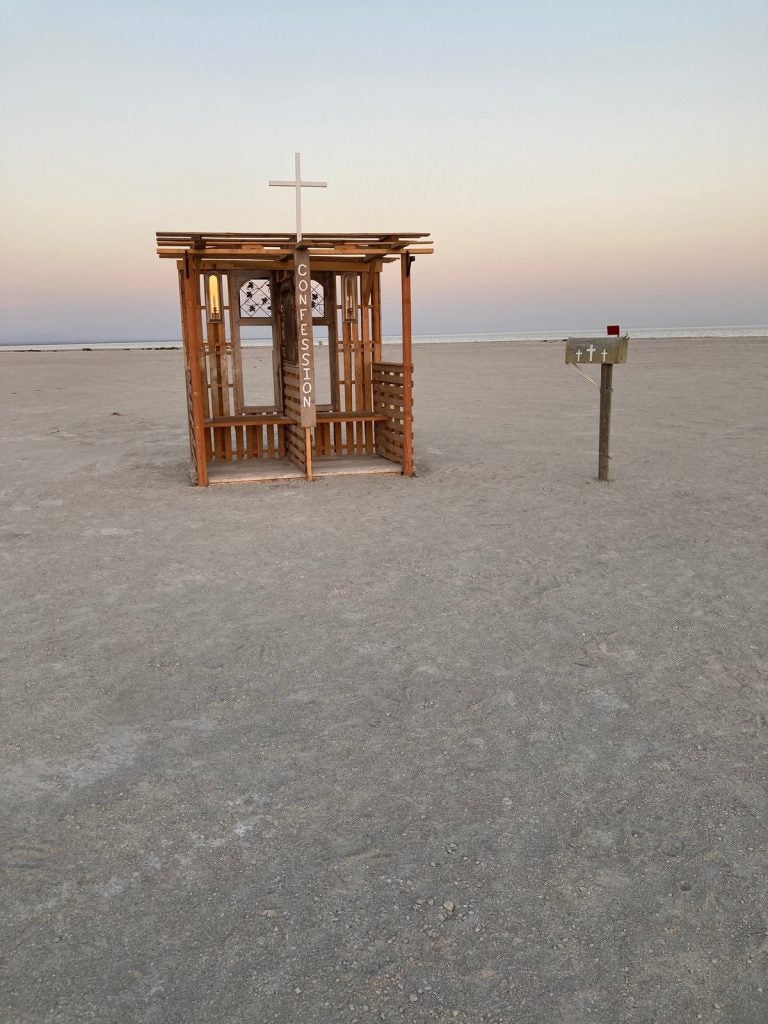
For his part, Johnson describes the Fourth of July back then as “12 rows of RVs, each one of them half a mile long.” At one point in the early 1970s, the Salton Sea attracted more visitors than Yosemite.
Today, most people who pass through can be divided into two camps: Those who get it, and those who don’t. In terms of the latter, Jones tells me about how some people open the door to the Skin Inn, one of two bars in town, and quickly get back in their cars and drive straight out of town. Others, typically filmmakers, photographers and writers are drawn by the promise of trawling for scraps of meaning in a lake that might not be there tomorrow.
Christopher, an early thirtysomething from Oregon with sun-kissed skin, a rust-colored beard and a nascent paunch who isn’t wearing shoes or a shirt, is among the newbies who get it. After he left Burning Man six months ago, he came to Bombay Beach, found a bed for a few nights and never left. Last week, he volunteered to become the town’s only firefighter. Their previous firefighter died of natural causes a few months earlier. When he did, Imperial County, the poorest region in Southern California, took away Bombay Beach’s only fire truck since there was no one to operate it. Christopher, who’s still in training, rides around on a golf cart loaned to him by another Bombay Beach resident. He carries around a Motorola walkie-talkie that sparks to life every few minutes with the voice of a dispatcher.
He has tasked himself with protecting a town where most of the homes and trailers are in varying states of decay. The grid is a half-mile long and divided into five streets and nine avenues. Most of the plots of land have long been abandoned. Some are covered in graffiti. Others have been turned into art installations. The area pigeons spend most of their time traveling from power lines to rooftops to a 25-foot metal fish built from a discarded airplane fuselage that’s perched roughly 15 feet in the air.
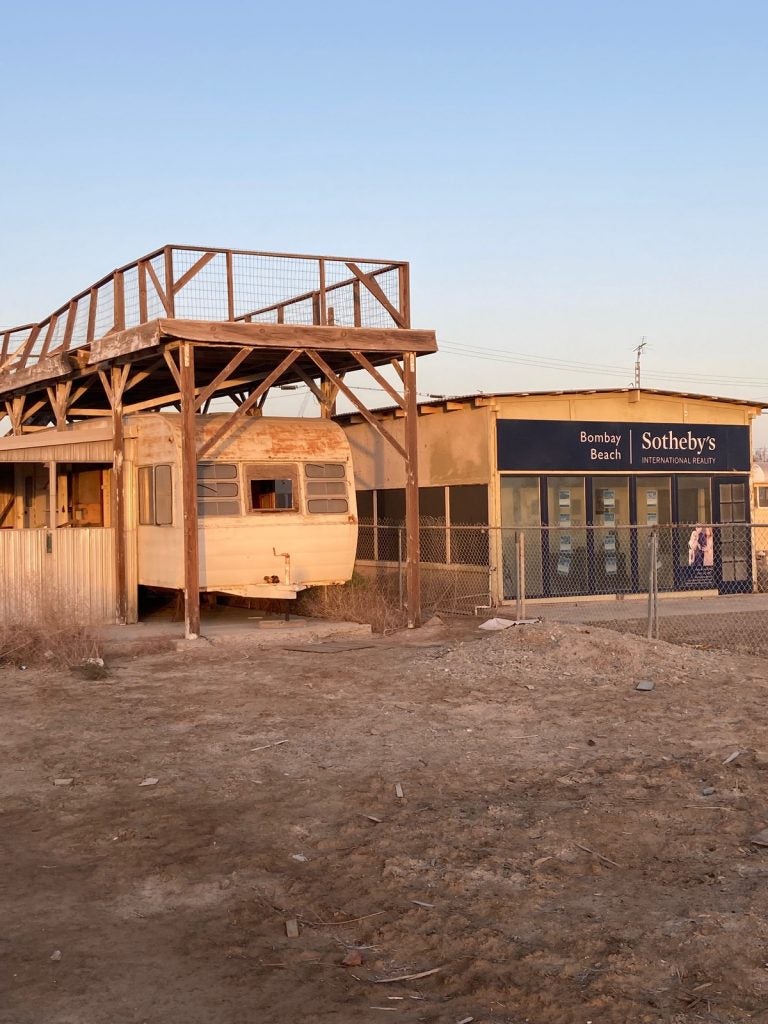
In the early 1980s, Jones relates buying a house in Bombay Beach to buying a piece of land in the Florida Everglades: It was entirely possible that your new domicile could be devoured by the Salton Sea at any moment. Tropical storms led to major overflow causing agricultural runoff from neighboring farms in the Coachella Valley replete with fertilizers, pesticides and chemicals like DDT to surge into the water. At its peak, the water level rose 12 feet and a total of three blocks of Bombay Beach were swallowed up by the sea. The tourists stopped coming almost immediately.
Ever since, the Salton Sea has more or less receded at a rate of nearly 500 billion gallons per year. This process went into overdrive in 2003, when San Diego County made a deal that gave the Imperial Irrigation District billions of dollars for improving irrigation infrastructure in exchange for as much as 54 billion gallons of water per year. All of which has put the Salton Sea on an accelerated path toward extinction and exposed Bombay Beach’s inhabitants to toxic chemicals like arsenic, selenium and DDT.
One of the last times Jones went fishing in the Salton Sea was in 2001. “There was an old man in a pickup truck named Two Jig Bob,” he tells me. “He had five fish, and they were so big that he couldn’t get them into the back of his truck.” After Jones and his buddy helped him, they went out into the lake and dropped their line in four feet of water the color of ketchup. “You couldn’t even see the end of the line,” he says.
In a matter of a few hours, Jones caught nine 15-pound corvina with a dozen tilapia. He didn’t eat any of them — but only because he had plans to go fishing in San Diego later that day. Today, Mullet Island, the area where he caught the fish, is a peninsula due to the amount of water that’s receded over the years.
By 2008, there were still some corvina left, “but they looked like a fish rack with just bones and skin due to the high salinity,” Jones says. The thing is, Johnson explains, if the water wasn’t so salty, it would pass an EPA test. “Anytime anyone did a story on Bombay Beach, they always used the words ‘toxic,’ ‘fetid’ and ‘cesspool,’” he tells me. “But I only stopped going in the water a year ago because I got lazy and I don’t want to walk out a half a mile.”
Filmmaker Tao Ruspoli first learned about Bombay Beach from a book he found in 2008. “It embodied a lot of contradictions,” he says. “The sea is both artificial and one of the most important natural environments for the migratory path of hundreds of birds since most of the wetlands along the California coast have been developed.” After he finished the book, Ruspoli got in his car and drove here from L.A. Fourteen years later, he owns three Airbnb properties, one of which I’m staying in.
According to Ruspoli, you can’t overstate the profound state of dilapidation that existed in Bombay Beach in 2008. “The artist community has probably taken 40 dumpsters’ worth of trash out of Bombay Beach since we’ve been there,” he explains. Johnson and Jones confirm as much. “If the artists hadn’t come in here, this place would have been in a state of morbid decay,” says Jones. “Except for the Skin Inn, this place would have been an actual ghost town.”
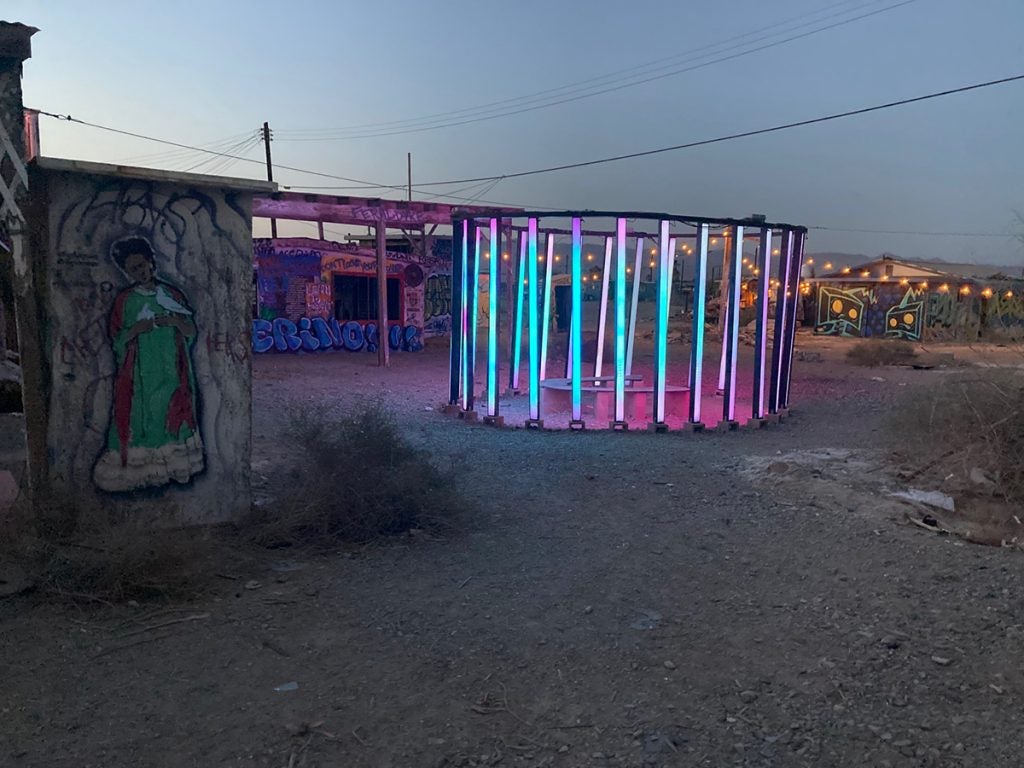
At first, the artist community consisted mainly of Ruspoli and a few of his friends. Then came the BBAC group, which Jones describes as “mostly fine arts and ceramics types.” Their stated mission is to “improve the quality of life for impoverished farming communities globally.” The next arrival was the Mars crew, who Johnson describes as “trust-fund Gen Z kids with good intentions” and all about “having zero carbon footprint.” In 2015, Ruspoli and his group started the Bombay Beach Biennale, a “moveable feast of installations, talks, parties and performances.”
Most of the artists, however, escape Bombay during the summer months when the weather gets too hot. They leave behind a stark reality where residents are in the state’s 95th percentile for poverty, 88th percentile for asthma, 99th percentile for unemployment and 83rd percentile for low birth weight. Hospitalization rates for children with asthma are double the state average, with one in five kids affected. “People end up here because they can’t afford anywhere else,” says Jones. “Others are trapped here because they can’t afford to leave. Most people here live out of the mailbox so it’s either welfare, disability or social security.”
Which is to say, along with impaired water sources, chemical waste sites and unhealthy levels of ozone and particulate matter, despair is the other major contaminant in Bombay Beach. During my weekend stay, I’ll learn that one of the installations — concrete steps that lead into the Salton Sea — was made by a 57-year-old artist who died by suicide last year. And at the Ski Inn, the owner tells me that another man in his 60s did the same last week. “Somewhere along the way, they have family issues, mental issues and health issues. Then there’s the heat, and so they think, ‘You know what, I’m just about done with this,’” says Jones.
The desert is obviously in the eye of the storm of our climate crisis. And those who dwell there are already on the frontlines of oppressive heat waves, water shortages and chemical ruin. Scholars call this — and particularly, the Salton Sea — a “wicked problem,” or a quandary so complex as to defy any conceivable solutions.
Johnson has definitely noticed the temperature getting hotter sooner and remaining that way for longer. In January, he says there was a week where it was in the upper 90s. In February, there was another week where it was over 100. The same held true for March. “Every year since about 2014, it gets longer and longer and longer,” Johnson says. “There hasn’t been hardly any snow on San Jacinto. And if it does snow, it disappears in a week.”
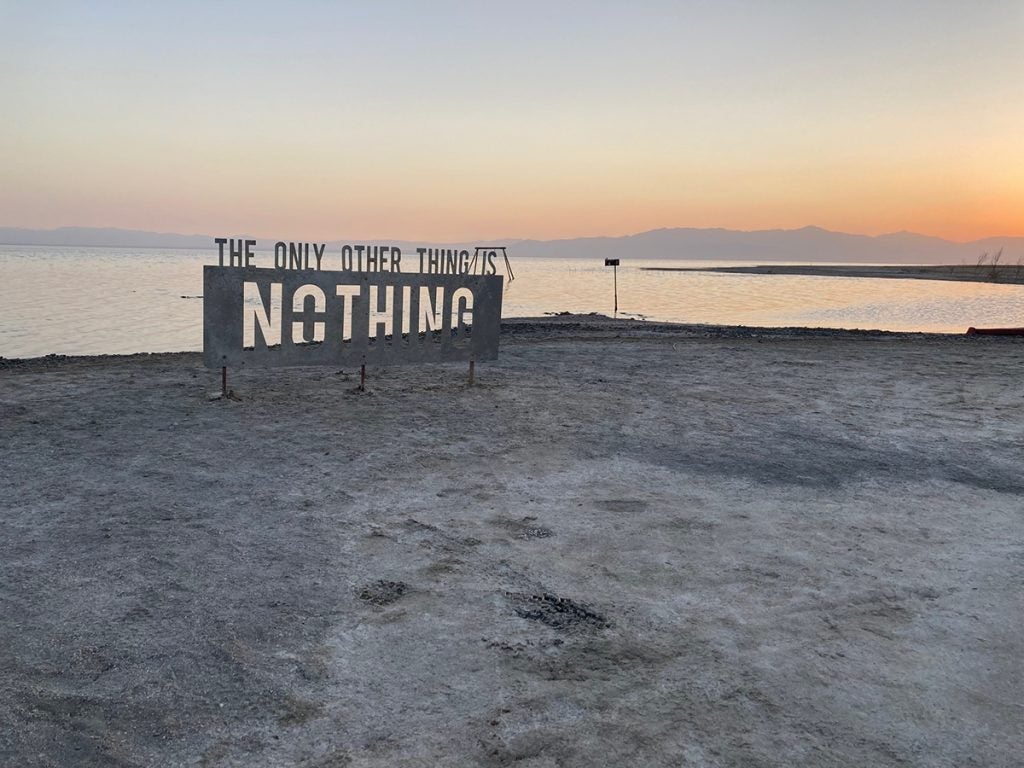
The recent arrival of lithium mining plants has led some locals to believe that at least a little cash is in the offing. Money, however, can’t produce more water. If anything, it’s the exact opposite: For Berkshire Hathway, which currently owns 10 geothermal mines in the surrounding area, the Salton Sea is little more than an obstacle standing in the way of the “new gold rush.” “They want the south end of the lake to dry up,” says Johnson. “There’s a vested interest in that happening.”
Jones remains hopeful, but he admits that the Salton Sea is likely to follow the same trajectory as a lake 288 miles to the north, along the eastern side of the Sierra Nevada. In 1913, water from Owens Lake was diverted into the Los Angeles Aqueduct until the 96-square-mile lake was desiccated. Today, it’s the single largest source of dust pollution in the country.
But that’s really only a future for the rest of us to obsess over, projecting our own harbingers of doom and gloom and climate catastrophe on this dwindling sea and its ever-growing beachfront. “We get a lot of zombie movies here,” Johnson tells me matter-of-factly. It’s not like that for Johnson, Jones and everyone else in Bombay Beach, though. For them, it’s just home.

